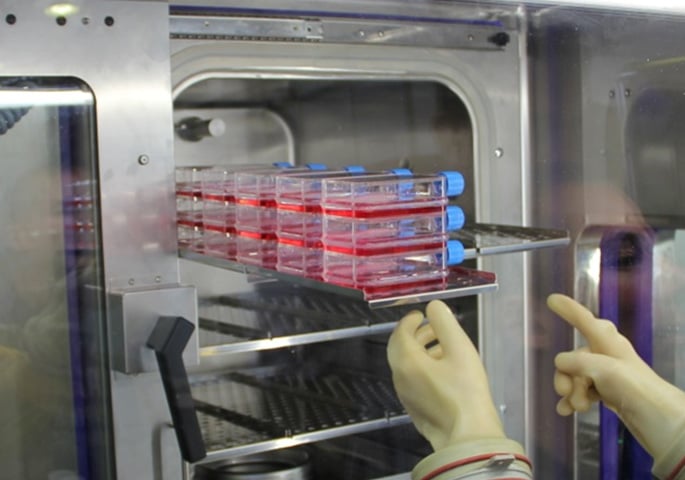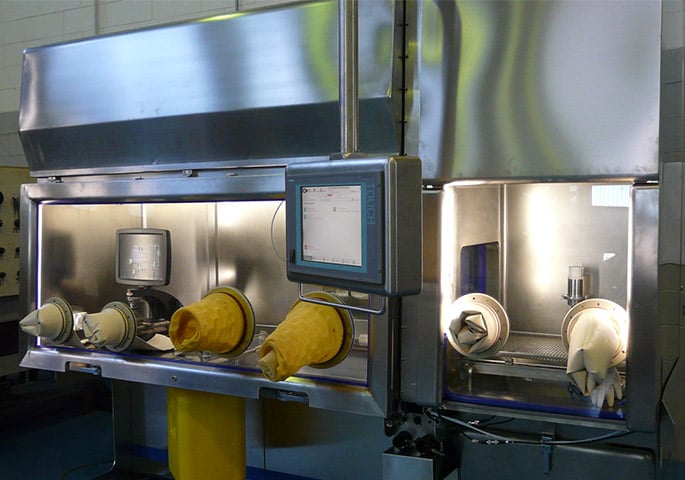Tasks and objectives:
- Isolator with integrated incubator
- Safe and efficient cultivation of cellular tissue
- Time and cost savings
- Reliable decontamination
- Homogeneous temperature distribution
- Easy operation
BINDER solution:
- Modifications made to CB 160 incubator according to requirements
- Heat-sterilizable sensor
- Gas-proof incubator
- Sliding door with control lever
- Pull-out shelves with stainless-steel hooks
- Specially developed frame
- Clear control panel
- APT.line air jacket system
- 180°C hot-air sterilization


In biomedical research and application, regenerative technologies are among the most innovative and promising fields of the future. Regenerative medicine is concerned with healing different illnesses by repairing dysfunctional cells, tissues, and organs, both through biological replacement, for example, using cultivated tissues, as well as by stimulating the body‘s own regeneration and repair processes. Cultivating cell tissue involves removing skin from the patient, multiplying it in the laboratory, and later implanting it into the patient. This new form of therapy is of ground-breaking significance for victims with extensive burns, as significant scars form as a result of traditional transplantation procedures which often stay with the patient for the rest of their life.
To date, however, producing human skin has required significant effort and the fulfilment of the very strictest safety requirements. The process of skin cultivation must be carried out in a class A cleanroom, which is the highest safety class. Personnel may only enter the cleanroom in which the incubator is located via an air lock and must go through an extremely time-consuming cleaning procedure in advance which takes 30 minutes or more. The time allowed in the cleanroom is limited to a maximum of four hours, as otherwise there is the risk of contaminating the samples. Due to all the effort required, this procedure is not only extremely time-consuming, but also costly.
As there is a great need for artificial human skin, a university hospital in Switzerland commissioned a large-scale project in 2009 with the aim of making the process of human skin production much more efficient. The basic idea involved restricting the cleanroom climate to the isolator (glove box) and integrating the incubator chamber as a separate unit in the isolator. This has the enormous advantage that the time-consuming cleaning process is no longer necessary for personnel, as cleanroom class D is sufficient for the isolator‘s environment. As laboratory personnel may also work in the room for eight hours instead of only four, this process is not only more efficient, but also more cost-effective. To this end, a center is planned for the cultivation of human skin with the intention of equipping it with five isolators and five incubators. The company Sysmex Suisse AG planned and implemented the large-scale construction project; it was also responsible for organization, and coordinated and guided the various tasks among a total of ten
project partners. BINDER was assigned the project task of modifying the CB 160 incubators. The entire planning phase turned out to be extremely complex: At the heart of it was the CB 160 gassed incubator from BINDER with heat-sterilizable sensor. The incubator‘s stainless steel chamber is integrated into the cleanroom. The lab assistant places the laboratory samples which were held at cleanroom class D into an isolated area (air lock). The air is cleansed in the air lock: Suction of the particles raises the area from class D to class A. Then the sample slide goes through a further air
lock into the class A area of the module in which the incubator is permanently installed. The unit is controlled by a control panel located outside of the cleanroom in the laboratory. The lab assistant can place the samples in the incubator using glove access ports.
The waste receptacle is also integrated into the cleanroom. As this must never be opened when the incubator is open due to contamination, it is fitted with a sensor that detects when the incubator is open. In addition, the cleanroom had to be completely sealed where the incubator is installed. “Overpressure tests are carried out in the cleanroom to test the seals,” says Bernd Hofmann of BINDER GmbH. “The pressure drop must change within the specified time. The way this safety concept is implemented is as yet unparalleled in Europe.” Sensors are redundant. Each incubator is fitted with two elements for temperature, CO2, and O2, so that an alarm is sounded in an emergency. But other major modifications were also made to the CB 160. The incubator was made gas-proof to avoid contamination. To save space in the cleanroom, the original hinged door was replaced by a sliding door with a specially developed control lever. This can be swiveled so that the lab assistant is not restricted while they are working with their gloves. The incubator is also fitted with three pull-out shelves. These are specialized equipment, as ball bearings do not conform to cleanroom requirements, so the shelves are secured by stainless steel hooks instead. This prevents the samples from sliding out or the shelves from falling. Even the incubator‘s glass door was omitted due to the risk of condensation. The incubator
stands on a specially developed frame which is installed in the isolator and can have its height adjusted. All the electronics were laid under the unit to make it easier to use.
Advantages
- BINDER Individual solution
- Best growth conditions
- Highly effective decontamination concept
- Easy to clean
- Made in Germany
Application field
- Cell cultures
- Tissue engineering